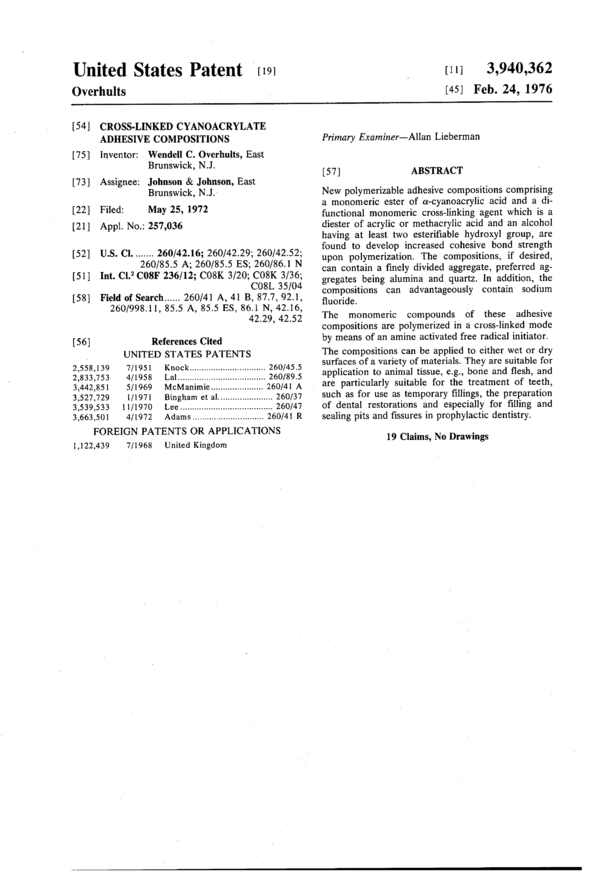Cross-Linked Cyanoacrylate Adhesive Composition
Folder:
Year:
Abstract:
New polymerizable adhesive compositions comprising a monomeric ester of .alpha.-cyanoacrylic acid and a difunctional monomeric cross-linking agent which is a diester of acrylic or methacrylic acid and an alcohol having at least two esterifiable hydroxyl group, are found to develop increased cohesive bond strength upon polymerization. The compositions, if desired, can contain a finely divided aggregate, preferred aggregates being alumina and quartz. In addition, the compositions can advantageously contain sodium fluoride.
Type of document:
Language:
United States Patent [191
Overhults
154] CROSS-LINKED CYANOACRYLATE
ADHESIVE COMPOSITIONS
[75] Inventor: Wendell C. Overhults, East
Brunswick, N.J.
[73] Assignee: Johnson & Johnson, East
Brunswick, N.J.
[22] Filed: May 25, 1972
[21] Appl. No.: 257,036
[52] U.S. Cl. ..... .. 260/42.16; 260/42.29; 260/42.52;
260/85.5 A; 260/85.5 ES; 260/86.1 N
[51] Int. Cl.” C08F 236/12; C08K 3/20; COSK 3/36;
COSL 35/04
[58] Field of Search .... .. 260/41 A, 41 B, 87.7, 92.1,
260/998.11, 85.5 A, 85.5 ES, 86.1 N, 42.16,
42.29, 42.52
[56] References Cited
UNITED STATES PATENTS
2,558,139 7/1951 Knock .............................. .. 260/45.5
2,833,753 4/1958 Lal ............................ .. 260/89.5
3,442,851 5/1969 McManimie . . . . . . . . . . . . . .3260/41 A
3,527,729 1/1971 Bingham et al.... .......... .. 260/37
3,539,533 11/1970 Lee .................................. .. 260/47
3,663,501 4/1972 Adams . . . . . . . . . . . . . . . . . . . . . .. 260/41 R
FOREIGN PATENTS OR APPLICATIONS
1,122,439 7/1968 United Kingdom
[11] 3,940,362
[45] Feb. 24, 1976
Primary Examiner—Allan Lieberman
[57] ABSTRACT
New polymerizable adhesive compositions comprising
a monomeric ester of wcyanoacrylic acid and a di-
functional monomeric cross—linking agent which is a
diester of acrylic or methacrylic acid and an alcohol
having at least two esterifiable hydroxyl group, are
found to develop increased cohesive bond strength
upon polymerization. The compositions, if desired,
can contain a finely divided aggregate, preferred ag-
gregates being alumina and quartz. In addition, the
compositions can advantageously contain sodium
fluoride.
The monomeric compounds of these adhesive
compositions are polymerized in a cross-linked mode
by means of an amine activated free radical initiator.
The compositions can be applied to either wet or dry
surfaces of a variety of materials. They are suitable for
application to animal tissue, e.g., bone and flesh, and
are particularly suitable for the treatment of teeth,
such as for use as temporary fillings, the preparation
of dental restorations and especially for filling and
sealing pits and fissures in prophylactic dentistry.
19 Claims, No Drawings
3,940,362
. 1 I
CROSS-LINKED CYANOACRYLATE ADHESIVE
* ' COMPOSITIONS
FIELD OF THE INVENTION
This invention relates to new and novel polymeriz-
Vable adhesive compositions. In particular, this inven-
tion relates to compositions comprising a monomeric
ester of a-cyanoacrylic acid and a difunctional mono-
meric cross-linking agent which is aldiester of acrylic or
' methacrylic acid and a polyfunctional alcohol having at
least two esterifiable hydroxyl groups. These composi-
’ tions have been found to be particularly useful in the
treatment of teeth. * r ‘
The compositions of this invention also include those
which in addition comprise, either alone or in combina-
' tion, a finely divided aggregate or filler, such as alu-
mina or quartz; and sodium fluoride as an adhesive
bond enhancing material. H l
While the compositions of this invention are in par-
ticular described in connection with those embodi-
ments that are primarily designed for use in the treat-
ment ‘of teeth, it should be understood that the compo-
sitions of this invention are not limited to such applica-
tion. These compositions can be utilized for filling or
bonding various other materials including, for example,
animal tissue such as bone, flesh, skin and the like and
also such porous and nonporous materials as ceramics,
glass, metal, wood and plastics together with joining or
_ filling other materials where the unique properties of
the present composition can be advantageously em-
ployed as will be apparent to those skilled in the art
I upon reading thisdisclosure.
DESCRIPTION OF THE PRIOR ART
Monomeric ester of ‘ a—cyanoacrylic acid - are well
known for use as adhesives. Upon polymerization, such
' compositions have been "utilized to join a variety of
materials, and such compositions and uses therefor are
described in U.S. Pat. No. 2,794,788. In addition, U.S.
Pat. No. 3,663,501, describes the use of compositions
comprising esters of oz—cyanoacrylic acid for use in the
treatment of teeth.
Many individuals have imperfections in the enamel
layer of their teeth, which imperfections are a potential
A site for the development of caries, especially if dental
hygiene is less than complete. Such imperfections are
most often found on the occlusive surfaces of the teeth.
' These imperfections are known as pits and fissures, and
heretofore known compositions incorporating esters of 50.
a—cyanoacrylic acid have‘ been utilized in dentistry to
seal such pits and fissures. The pit and fissure sealant
composition is applied in the fluid state to the occlusive
surfaces of cleaned teeth. Upon curing in situ there is
provided a protective layer which ‘seals the imperfec-
tions and discontinuities in the enamel layer, which
otherwise could permit bacteria to attack enamel and
, initiate decay. Unless dental care is made available,
such decay will ultimiately destroy the tooth structure.
Unfortunately, these linearly polymerized alkyl 2-
cyanoacrylates, while having‘ excellent adhesion to
'tooth surfaces do not develop an exceptionally high
cohesive strength. Such“ cohesive strength is desirable
to enable the cured sealant to withstand, over an ex- ‘
tended period, the grinding action and pressures expe-
rienced during mastication. ” ’ '
Furthermore, composi , ons ‘heretofore utilized as
dental restoratives, i.e., materials used to ‘fill prepared
Coments go here:
- Log in to post comments

